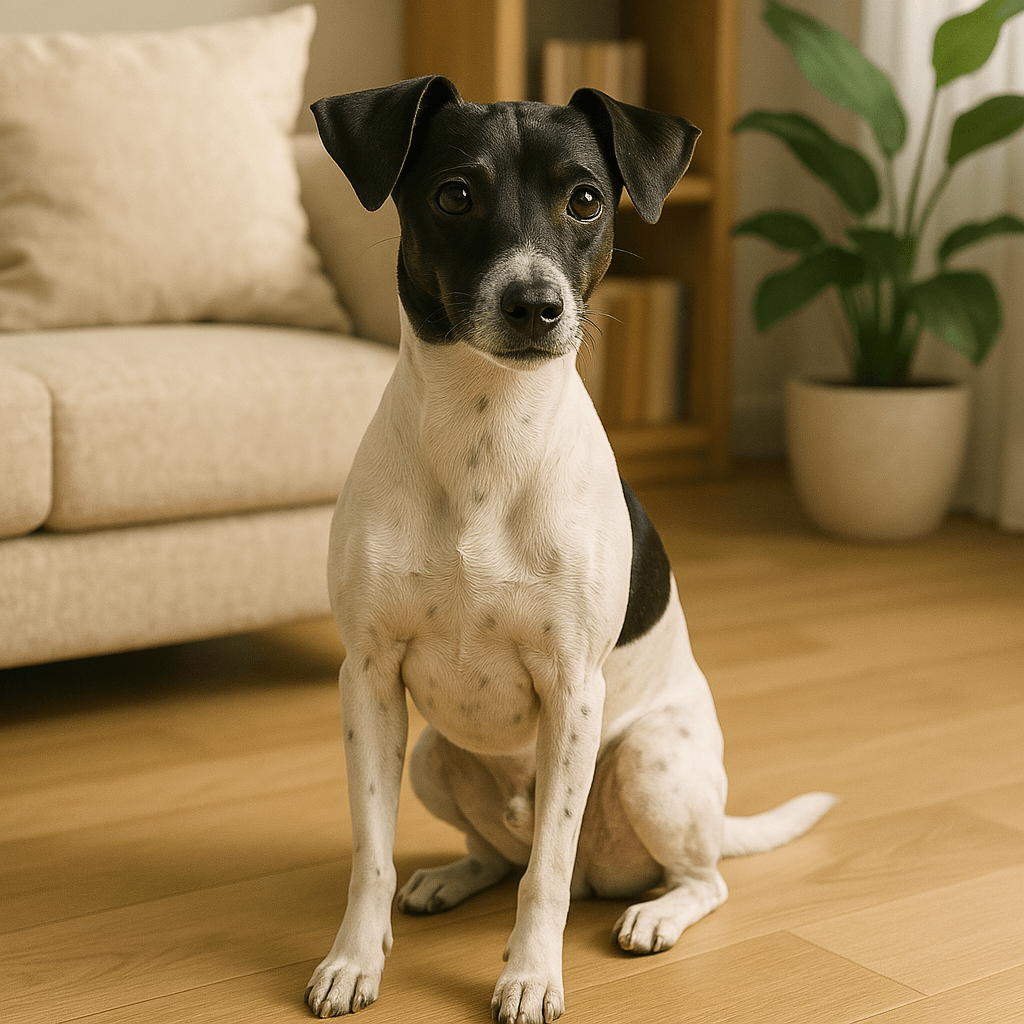
Japanese Terrier – an elegant dog from Japan that will steal your heart
🐾 Introduction
In a world of dogs full of diversity, some breeds can captivate with their mere appearance. The Japanese Terrier is one such dog – a small yet graceful four-legged creature that exudes class and subtle beauty. Although it remains one of the lesser-known breeds outside of Japan, its popularity is also beginning to grow in Europe and North America. This dog combines the qualities of an ideal companion with an aesthetic that will turn heads on a walk.
It's impossible not to notice his harmonious silhouette, contrasting coat, and agile movements—it's like elegance encapsulated in a canine form. However, appearance is only the beginning of the story. This dog harbors intelligence, devotion, and sensitivity that will make him a faithful companion for years to come.
In this article, you'll learn more about the Japanese Terrier (Nihon Teria) —its history, personality, needs, health, and grooming requirements. You'll also learn who this Japanese dog breed is best suited to and why it's worth considering if you're looking for the perfect apartment dog .
👪 Who is the Japanese Terrier for?
While the Japanese Terrier may seem like a breed created with aesthetes in mind, its character and needs make it an ideal pet for many types of owners. This Japanese dog thrives in urban environments, accommodating both seniors and young families.
Who will it work best for?
- For seniors: small, quiet at home and very affectionate.
- For families with children: gentle and loyal to children.
- For singles and couples: the perfect companion for everyday activities.
- For apartment block residents: quiet, clean, does not require much space.
Who is it not ideal for?
- For people who are often absent from home: they do not cope well with loneliness.
- For very active athletes: prefers moderate activity.
🗾 Origin and history of the breed
The official description of the breed can be found on the website of the Japan Kennel Club (JKC) – the organization that approved the breed standard in 1930.
The Japanese Terrier, also known as the Nihon Teria, was developed in the 17th century by crossing European Fox Terriers, brought by Dutch traders to the port of Nagasaki, with local Japanese dogs. The goal was to create a small, active companion dog, ideal for urban living. It's worth noting that, unlike many hunting dogs, the Nihon Teria was bred from the outset primarily as a house dog—loyal, aesthetically pleasing, and calm.
The breed was officially recognized by the Japanese Kennel Club (JKC) in 1930 and is currently listed by the FCI in Group 3 – Terriers. Although it has the status of a "national treasure of cynology" in Japan, it remains a unique breed abroad – often appreciated by enthusiasts of rare and unique breeds.
📏 Japanese Terrier - Appearance
This dog attracts attention with its slender silhouette, striking color contrast, and graceful movement. It has a very modern look—as if created with a modern lifestyle in mind. Elegant, light, and agile—it might resemble a work of Japanese design: functional, minimalist, and beautiful all at once.
Characteristic features:
- Height: 30–33 cm
- Weight: 4–6 kg
- Coat: short, silky, easy to care for
- Color: most often white body with a black or tricolor head
The head is well-proportioned, the eyes dark and expressive, and the ears triangular, often falling forward. The tail may be natural or docked (in countries where it is permitted). The movements of the Japanese Terrier are fluid and elegant—even feline.
🧠 Japanese Terrier - Character and temperament
The Japanese Terrier is an exceptionally sensitive, intelligent, and devoted dog. It's alert, energetic, and easily bonds with one person, though it also thrives in family settings. It's an ideal "canine companion" for single people or families with children, provided everyone treats it with respect.
Most important character traits:
- Gentle and calm at home
- Active and cheerful on walks
- He likes to be close to people – he is a "lap dog"
- Gets along well with children and other animals
- May be a bit shy around strangers - needs socialization
His loyalty can make him reluctant to be left alone. He can also be wary of strangers, making him a good, if unobtrusive, watchdog. His intelligence and empathy make him an excellent therapy dog.
🎓 Training – a smart and fast-learning dog
The Japanese Terrier is intelligent and eager to learn, but can also be a bit sensitive. Therefore, gentle training methods based on positive reinforcement work best. Their intellectual abilities make them excellent at learning commands, tricks, and canine sports like rally-o and nosework.
Tips:
- Start socialization and training from the first days
- Avoid shouting and nervousness - the dog gets discouraged quickly
- Rewards, praise and short sessions are the key to success
- He loves playing with the element of smell and quickly responds to his guardian's voice.
It's worth remembering that Japanese Terriers learn best through play and interaction with their owners. Left alone, they can quickly become bored and show signs of frustration.
🏡 Ideal living conditions
The Japanese Terrier thrives in an apartment, provided it receives adequate exercise and mental stimulation. This dog dislikes solitude and thrives in the company of its owner. It doesn't require a large yard or extreme activity, but it certainly appreciates daily walks and playtime.
Recommendations:
- Daily walks and games
- Access to interactive toys
- Constant contact with household members
- Avoiding long-term loneliness
Its compact size makes it an ideal apartment dog – quiet, tidy, clean, and non-destructive. It enjoys routine and emotional stability in its surroundings.
🧼 Care and health
Grooming the Japanese Terrier is relatively simple, thanks to its short, silky coat. It rarely sheds heavily, has no distinctive odor, and requires infrequent bathing.
Care:
- Regular brushing (1–2 times a week)
- Baths as needed
- Ear inspection and cleaning
- Regular claw trimming
Health:
The Japanese Terrier is generally a healthy breed, but may be prone to certain health conditions, such as:
- Patella luxation
- Legg-Calvé-Perthes disease
- Skin allergies
- The delicacy of a sensitive digestive system
A balanced diet, regular veterinary checkups, and an active lifestyle are key to maintaining good health. The average lifespan of this breed is 12–15 years.
🧳 Accessories and equipment
To ensure comfort and safety for your Japanese Terrier, it is worth purchasing appropriate accessories:
- Bed: Soft and cozy, adapted to his size
- Harness and leash: Light and comfortable, providing control during walks
- Interactive Toys: Stimulating the Mind and Preventing Boredom
- Clothes: Protecting against the cold on colder days
- Transporter: Small and comfortable – perfect for traveling
It is also worth considering sniffing toys and activity mats, which are great for training and filling time at home.
🔄 Comparison with other breeds
| Trait / Race | Japanese Terrier | Jack Russell Terrier | Toy Terrier / English Toy | Fox Terrier (short-haired) |
| Growth | 30–33 cm | 25–30 cm | 24–28 cm | 35–39 cm |
| Libra | 4–6 kg | 6–8 kg | 2–4 kg | 7–9 kg |
| Energy level | Moderate | Very high | Low-medium | Tall |
| Training difficulty | Easy – sensitive | More difficult – stubborn | Easy | Moderate |
| Coat care | Very easy | Easy | Very easy | Easy |
| Sociality | Tall but shy | Extroverted | Introverted | High |
| Lifestyle | Perfect for an apartment | I need a garden | He tolerates silence well | I need space |
| Recommended for | Seniors, families, couples | Physically active people | Seniors, homebodies | Families with a garden |
🌸 Interesting facts about the breed
Learn lesser-known but incredibly fascinating facts about the Japanese Terrier that will surely surprise many dog lovers:
- National Dog of Elegance: The Japanese Terrier is sometimes called the "Geisha Dog" – not only because of its Japanese origins, but also for its gentleness, subtle movements and distinguished appearance.
- Cultural Presence: Although not frequently featured in pop culture, the breed can be seen in niche Japanese manga and Taisho-period illustrations. They are considered to be the epitome of 1930s urban lifestyle.
- Nihon Teria Name: The original name in Japanese is "日本テリア" (Nihon Teria), which literally means "Japanese terrier".
- Breed rarity: This is one of the rarest breeds in the world – the population of Japanese terriers still does not exceed a few thousand individuals globally, most of which live in Japan.
- The Japanese love for small dogs: the Nihon Teria was especially popular in Osaka and Tokyo as a companion dog for small apartments. To this day, it is considered a typical urban breed.
❓ FAQ – Frequently Asked Questions
Does a Japanese Terrier bark a lot?
No. He's rather quiet, only barking when necessary.
Does it shed hair?
Very little. Regular brushing is sufficient.
Can he be left alone?
Not for long – he doesn't cope well with loneliness.
How much does a puppy of this breed cost?
From 4,000 to 8,000 PLN – this is a very rare breed.
Is it suitable for beginners?
Yes, if the caregiver devotes time and attention to him.
Can you travel with this dog?
Of course – it is a compact and calm traveling dog.
📌 The most important information at a glance
| Characteristic | Description |
| Origin | Japan, 17th century |
| Height | 30–33 cm |
| Libra | 4–6 kg |
| Hair | Short, silky, easy to care for |
| Character | Sensitive, intelligent, loyal |
| Activity | Moderate, daily walks and play |
| Care | Simple, regular brushing and bathing |
| Health | Generally good, some illnesses possible |
| Life expectancy | 12–15 years old |
If you're looking for a small apartment dog that's elegant, easy to train, and very affectionate, the Japanese Terrier (Nihon Teria) is the perfect choice. Its personality and appearance make it one of the most underrated gems in the world of cynology.
📚 Additional materials
- 🏙️ Best dogs for apartments – breed ranking
- 💬 How Do Dogs Show Affection? Signals You Should Know
- 🐕 Is your dog pulling on the leash? Find out how to fix it.
- 🚗 How to safely transport a dog in a car?
- 🐾 How to teach your dog to stay home alone
- 🛏️ Can a dog sleep in bed with its owner? Facts, myths, and behavioral advice.
See more at: Petto.com.pl














































 https://petto.com.pl
https://petto.com.pl